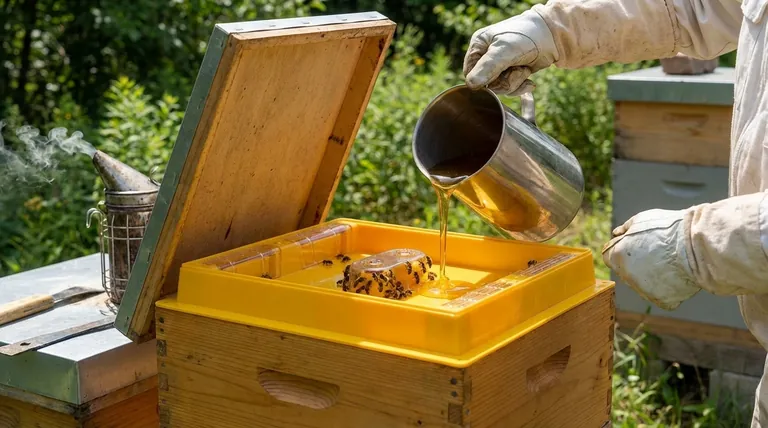In beekeeping, a top feeder is a high-capacity reservoir for sugar syrup or water placed at the very top of the hive. It sits directly on the frames of the uppermost hive box, positioned just beneath the inner and outer covers, allowing for easy refilling with minimal disturbance to the colony.
The primary advantage of a top feeder is its ability to deliver large volumes of feed efficiently and safely, making it a preferred tool for rapidly building up a colony's strength or preparing it for winter.

The Core Function of a Top Feeder
A top feeder serves as an external pantry for the honey bee colony. Its design prioritizes capacity, ease of access for the beekeeper, and safety for the bees.
Defining the Design
Top feeders are essentially trays or enclosed boxes designed to hold liquid feed. They are constructed to match the dimensions of the hive body (e.g., for a 10-frame Langstroth hive) to ensure a proper fit.
Strategic Placement
The feeder is placed directly on top of the uppermost box of the hive. This strategic location keeps the food source close to the cluster of bees, especially during cooler weather when bees are less likely to travel far.
High-Capacity Feeding
One of their most significant features is their volume. A standard top feeder for a 10-frame hive can hold up to three gallons of syrup, far more than other common feeder types. This reduces the frequency of refills required by the beekeeper.
The Strategic Advantages
Beekeepers often choose top feeders for specific, practical reasons that benefit both the colony and the manager of the apiary.
Minimal Disturbance to the Colony
Because the feeder is located at the very top of the hive stack, a beekeeper can refill it simply by removing the outer cover. This eliminates the need to "break open" the hive and disturb the brood nest, reducing stress on the bees.
Safety by Design
Most modern top feeders include features to prevent bees from drowning in the syrup. This is often accomplished with a central access point surrounded by a wire mesh screen or a floating raft that allows bees to access the feed without falling in.
Durability and Construction
Top feeders are generally considered to be among the most well-built and durable feeder types. Their solid construction is designed to withstand the elements and the weight of several gallons of liquid.
Understanding the Trade-offs
While effective, top feeders are not without potential downsides. An objective assessment requires understanding their limitations.
Risk of Chilling the Brood
In colder climates or during cool spring and fall weather, a large volume of cold syrup situated directly above the bee cluster can act as a "cold sink." This can make it more difficult for the bees to maintain the crucial temperature of the brood nest below.
Potential for Leaks and Robbing
A poorly constructed, damaged, or improperly seated top feeder can leak syrup down into the hive. This can drown bees and, if it leaks outside the hive, can incite "robbing" from other nearby colonies, which can be disastrous for a weaker hive.
Making the Right Choice for Your Goal
Selecting a feeder depends entirely on your management goals for a specific colony at a specific time of year.
- If your primary focus is rapid population growth or winter preparation: The high capacity and minimal disturbance of a top feeder make it the ideal choice.
- If your primary focus is providing a slow, steady stimulus to a small colony: A top feeder may be overkill; a smaller in-hive or entrance feeder might provide better control.
- If your primary focus is beekeeping in a cold climate: Use a top feeder with caution, ensuring you only feed when ambient temperatures are warm enough to prevent chilling the colony.
Ultimately, understanding the tool's strengths and weaknesses allows you to use it effectively to support a thriving, healthy colony.
Summary Table:
| Feature | Description |
|---|---|
| Placement | On top of the uppermost hive box, beneath the inner and outer covers. |
| Primary Use | High-capacity feeding for rapid colony buildup or winter preparation. |
| Key Advantage | Minimal disturbance to the colony during refilling. |
| Capacity | Holds up to 3 gallons of syrup for a 10-frame hive. |
| Key Consideration | Risk of chilling brood in cold weather; potential for leaks. |
Ready to equip your apiary with durable, efficient top feeders?
HONESTBEE supplies commercial apiaries and beekeeping equipment distributors with high-quality, wholesale-focused beekeeping supplies. Our top feeders are designed for maximum capacity and minimal bee disturbance, helping you build stronger colonies efficiently.
Contact HONESTBEE today to discuss your wholesale needs and enhance your beekeeping operation.
Visual Guide

Related Products
- Professional Hive Top Bee Feeder for Beekeeping
- Boardman Entrance Bee Feeder Durable Galvanized Steel and Wood Construction for Beekeeping
- Classic Boardman Entrance Bee Feeder Hive Front Feeding Solution
- HONESTBEE Professional Hive Top Bee Feeder Feeding Solution
- HONESTBEE Round Hive Top Bee Feeder for Syrup
People Also Ask
- What are the advantages of using top feeders for bees? Maximize Feeding Efficiency & Colony Safety
- How is the plywood floor fitted into the hive-top feeder? Ensure Longevity with a Floating Floor Design
- What types of hive boxes is the round hive top feeder compatible with? Universal Fit for 8 & 10-Frame Langstroth Hives
- What are the advantages of hive top feeders? Maximize Feeding Efficiency for Your Apiary
- What are the features of top feeders for bees? Maximize Hive Health with Safe, High-Capacity Feeding



















